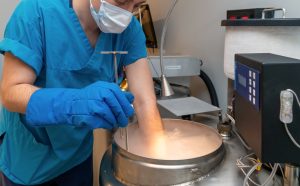Non-Invasive Glucose Monitoring: A Shift in Diabetes Care
Diabetes management has long been a challenge due to the need for frequent blood glucose monitoring, often requiring invasive finger-prick tests.
However, recent advancements in non-invasive glucose monitoring technologies promise a more convenient and less painful approach. This method involves measuring blood sugar levels without the need for skin penetration, enhancing patient comfort and compliance.
What You Need to know about Glucose Monitoring
Glucose monitoring is an essential aspect of diabetes management, allowing individuals to track their blood sugar levels and adjust their treatment accordingly. Recent advancements in this field have led to the development of various methods and technologies, enhancing both the accuracy and ease of glucose monitoring:
- Traditional Blood Glucose Monitoring: This method involves pricking the finger to obtain a blood sample, which is then tested using a glucose meter. Despite being invasive, it remains a widely used and reliable method for immediate glucose level assessment.
- Continuous Glucose Monitoring (CGM): CGM devices measure glucose levels at regular intervals throughout the day and night. A small sensor inserted under the skin continuously records glucose levels, providing real-time data and trends. This helps in better managing glucose fluctuations and understanding the impact of diet and exercise on blood sugar levels.
- Flash Glucose Monitoring: Similar to CGM, flash glucose monitoring involves a sensor placed on the body. However, it requires the user to ‘scan’ the sensor with a device to get the glucose reading, rather than providing continuous data.
- Smartphone Integration: Many modern glucose monitoring devices connect with smartphones, allowing users to track and record their glucose levels more efficiently. This integration also often includes features like trend analysis, reminders, and the ability to share data with healthcare providers.
- Artificial Intelligence and Machine Learning: These technologies are being integrated into glucose monitoring systems to predict glucose level trends, offering personalised recommendations for diabetes management.
- Wearable Technology: Wearable devices, like smartwatches, are being explored for their potential in non-invasive glucose monitoring, aiming to provide real-time glucose data in a user-friendly manner.
Understanding the Technology Behind Non-Invasive Monitoring
Non-invasive glucose monitoring technologies have made significant strides in recent years, employing various methods to measure glucose levels without the need for invasive procedures. This technology can be primarily classified into three categories:
Glucose monitoring is an essential aspect of diabetes management, allowing individuals to track their blood sugar levels and adjust their treatment accordingly. Recent advancements in this field have led to the development of various methods and technologies, enhancing both the accuracy and ease of glucose monitoring:
- Optical Methods: These involve the use of light-based technologies for detecting changes in glucose levels. Optical methods include Near-Infrared (NIR) technology and NIR Photoplethysmography (PPG), which are used for blood glucose prediction.
- Microwave Technology: This approach utilizes microwave electromagnetic waves to detect glucose levels. It is one of the key areas in the non-invasive blood glucose detection landscape, offering an alternative to traditional blood sampling methods.
- Electrochemistry: This method is based on the electrochemical properties of glucose. It plays a crucial role in the development of non-invasive glucose monitoring systems, especially in the context of wearable sensors designed for continuous glucose monitoring.
Additionally, transdermal methods, which measure glucose levels through the skin, are also a part of the research landscape in non-invasive glucose monitoring.
This technology is gaining traction due to its potential to provide novel options for blood glucose monitoring at home. It addresses the challenges associated with adherence to traditional blood glucose monitoring methods. The advancements in non-invasive glucose monitoring technologies cover a wide range of disciplines, including medical, materials science, optics, chemistry, and biology, indicating a multidisciplinary approach to tackling the challenges in this field.
Benefits for Patients and Healthcare Systems
Non-invasive glucose monitoring significantly enhances patient and healthcare system experiences. Patients benefit from a more comfortable and less painful process, eliminating the need for frequent skin piercing.
This reduces the risk of infection and increases the likelihood of consistent monitoring adherence, as the process becomes less daunting. For healthcare systems, non-invasive methods translate to substantial cost savings.
There’s a reduced need for consumables such as lancets and test strips, which are traditionally used in invasive monitoring. Additionally, the potential for better disease management through consistent monitoring could lead to fewer complications and hospitalisations, further reducing healthcare costs and improving overall patient health outcomes.
Challenges and Future Prospects
The journey towards perfecting non-invasive glucose monitoring is not without its challenges. One of the primary hurdles is ensuring accurate device calibration, which is crucial for reliable glucose readings.
Moreover, variations in skin tone can affect the performance of some non-invasive devices, necessitating advanced algorithms and sensor designs to accommodate diverse populations. External factors, such as environmental interferences and individual lifestyle variations, also pose significant challenges.
The future, however, looks promising as ongoing research and technological advancements are steadfastly addressing these issues. Efforts are being made to enhance sensor accuracy and reliability, and to refine algorithms for better adaptability to skin tone variations and environmental factors.
As these challenges are gradually overcome, the prospect of non-invasive glucose monitoring becoming a widely accessible and reliable tool for diabetes management grows ever more tangible, paving the way for a new era in patient-centric healthcare.
A Step Towards Improved Diabetes Management
Non-invasive glucose monitoring signifies a significant step forward in diabetes care, offering a blend of convenience, safety, and accuracy. As technology evolves, it holds the potential to revolutionise diabetes management, improving quality of life for millions worldwide.
References
- Hina, A., & Saadeh, W. (2022, June 27). Noninvasive Blood Glucose Monitoring Systems Using Near-Infrared Technology—A Review. Sensors, 22(13), 4855. https://doi.org/10.3390/s22134855
- Ma, R., Shao, R., An, X., Zhang, Q., & Sun, S. (2022, January 1). Recent advancements in noninvasive glucose monitoring and closed-loop management systems for diabetes. Journal of Materials Chemistry B. https://doi.org/10.1039/d2tb00749e
- Bolla, A. S., & Priefer, R. (2020, September 1). Blood glucose monitoring- an overview of current and future non-invasive devices. Diabetes & Metabolic Syndrome: Clinical Research and Reviews. https://doi.org/10.1016/j.dsx.2020.05.016
- New Technologies in Diabetes Care and Management. (2023, June 13). National Institute of Diabetes and Digestive and Kidney Diseases. https://www.niddk.nih.gov/health-information/professionals/diabetes-discoveries-practice/new-technologies-in-diabetes-care-and-management
- Lee, I. Y., Probst, D., Klonoff, D. C., & Sode, K. (2021, June 1). Continuous glucose monitoring systems – Current status and future perspectives of the flagship technologies in biosensor research –. Biosensors and Bioelectronics. https://doi.org/10.1016/j.bios.2021.113054
- Tran, J., Tran, R., & White, J. R. (2012, October 1). Smartphone-Based Glucose Monitors and Applications in the Management of Diabetes: An Overview of 10 Salient “Apps” and a Novel Smartphone-Connected Blood Glucose Monitor. Clinical Diabetes. https://doi.org/10.2337/diaclin.30.4.173
- Bailey, C. J., & Gavin, J. R. (2021, January 1). Flash Continuous Glucose Monitoring: A Summary Review of Recent Real-World Evidence. Clinical Diabetes. https://doi.org/10.2337/cd20-0076













